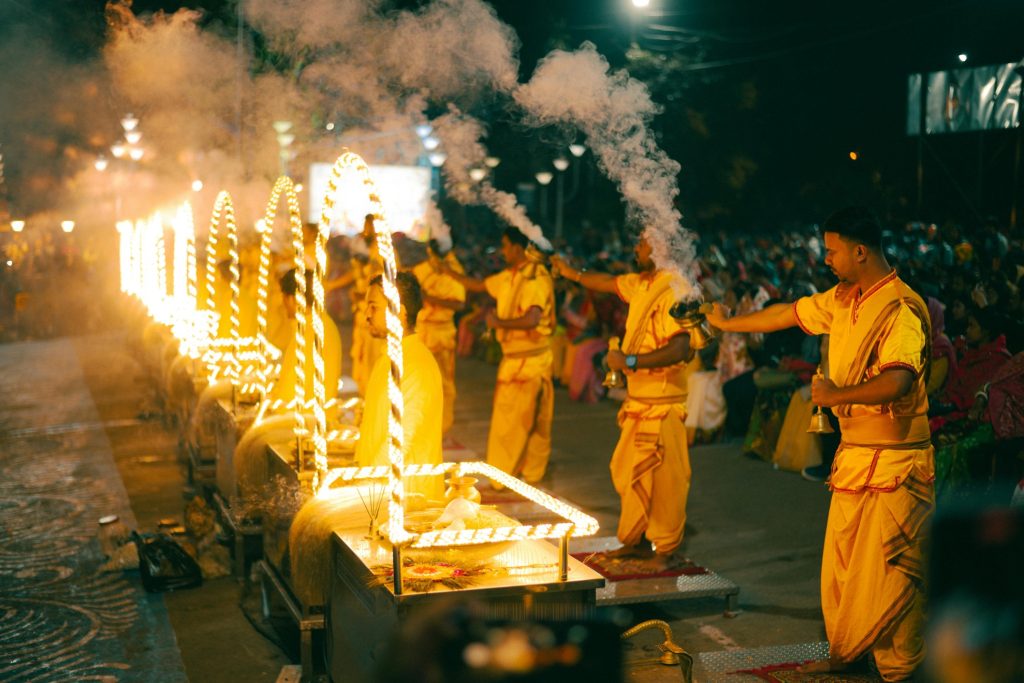Top 7 Ghats in Varanasi for a Divine Experience

Varanasi, the world’s oldest living city, is a sacred destination for pilgrims and spiritual travelers. Situated on the banks of the holy River Ganges, the city’s iconic ghats define its deep-rooted religious heritage, historical significance, and cultural vibrancy. With over 80 ghats in Varanasi, each holding its own importance, choosing the most spiritual ones can be overwhelming. Here, we highlight the top 7 ghats in Varanasi, each offering a unique divine experience and fascinating insights into their history and religious significance. 1. Dashashwamedh Ghat – The Spectacular Ganga Aarti Experience Dashashwamedh Ghat is one of the most famous ghats in Varanasi, renowned for its magnificent Ganga Aarti held every evening. The ghat’s name originates from a mythological tale where Lord Brahma is believed to have conducted the Dashashwamedh Yajna (a ritual of sacrificing ten horses) here to honor Lord Shiva. Why Visit? Experience the grand Ganga Aarti, a mesmerizing ritual with synchronized chants, fire lamps, and devotional music. Best Time to Visit: Arrive by 5:30 PM to secure a good spot before the Aarti begins. Spiritual Significance: Taking a holy dip in the Ganges at this ghat is believed to cleanse sins and bestow divine blessings. Pro Tip: For the best view of Ganga Aarti, rent a boat and watch the ceremony from the river. 2. Assi Ghat – A Tranquil Spiritual Retreat Situated at the confluence of the Ganges and Assi River, Assi Ghat is a revered spot for yoga, meditation, and spiritual seekers. According to legend, Lord Shiva threw his sword (Assi) here after slaying a demon, giving the ghat its name. Why Visit? A peaceful escape from the crowded ghats, ideal for morning prayers and meditation. Morning Bliss: Participate in Subah-e-Banaras, featuring sunrise Ganga Aarti, classical music, and yoga sessions. Serene Atmosphere: Less crowded than Dashashwamedh Ghat, making it perfect for introspection. Pro Tip: Visit early morning to witness the magical sunrise over the Ganges. 3. Manikarnika Ghat – The Gateway to Moksha Manikarnika Ghat is one of the most sacred cremation ghats in Varanasi, where Hindu funeral rituals are performed continuously. It is believed that those cremated here attain moksha (liberation from the cycle of birth and death). Why Visit? A deeply spiritual and thought-provoking experience, offering insights into Hindu philosophy on life and death. Mythological Significance: According to legend, Goddess Parvati lost her Manikarnika (earring) here, giving the ghat its name. Eternal Fire: The funeral pyres never extinguish, symbolizing the endless cycle of existence. Pro Tip: Maintain a respectful and contemplative demeanor when visiting. Photography of cremation rituals is strictly prohibited. 4. Harishchandra Ghat – The Lesser-Known Cremation Ghat Named after King Harishchandra, who was known for his unwavering truthfulness, this ghat is another significant cremation site in Varanasi. It is believed that cremation here also leads to moksha. Why Visit? A quieter alternative to Manikarnika Ghat, offering a profound spiritual experience. Historical Significance: According to legend, King Harishchandra worked at this ghat as a cremation ground laborer to uphold his commitment to truth. Philosophical Essence: A visit here prompts deep reflection on life’s impermanence. Pro Tip: Approach with an open and contemplative mind to truly appreciate the spiritual depth of this ghat. 5. Kedar Ghat – A Sacred Pilgrimage Spot One of the most visited ghats in Varanasi, Kedar Ghat is home to the revered Kedareshwar Temple, dedicated to Lord Shiva. Known for its purifying waters, this ghat attracts pilgrims seeking spiritual rejuvenation. Why Visit? Considered to have one of the purest waters along the Ganges, making it ideal for ritual baths. South Indian Influence: The temple architecture showcases strong Dravidian elements, drawing many South Indian pilgrims. Pilgrimage Hub: Devotees visit to perform sacred prayers and religious rituals. Pro Tip: The underground spring believed to originate from Kedarnath makes this ghat’s water even more sacred. 6. Panchganga Ghat – The Sacred River Confluence Panchganga Ghat marks the confluence of five sacred rivers—Ganga, Yamuna, Saraswati, Kirana, and Dhutapapa (though only the Ganges is visible today). Why Visit? A serene and less crowded ghat, perfect for meditation and spiritual retreat. Historical Significance: Saint Tulsidas is believed to have composed part of the Ramcharitmanas here. Divine Ambiance: Home to several ancient temples, making it a key pilgrimage site. Pro Tip: Spend time here in silent contemplation to absorb the spiritual energy of the place. 7. Bhonsale Ghat – A Royal Architectural Marvel Built by the Bhonsale dynasty of Nagpur, Bhonsale Ghat is known for its magnificent Maratha and Rajasthani-style architecture. Why Visit? A picturesque ghat, ideal for those interested in history and architecture. Temples and Shrines: Features notable shrines like Lakshminarayan Temple and Shiva Temple. Photography Delight: The ornate stone balconies and intricate carvings make this ghat a hidden gem. Pro Tip: A great spot for photographers and history enthusiasts seeking tranquility amidst the spiritual chaos of Varanasi. Frequently Asked Questions (FAQ) Why is Varanasi famous? Varanasi is famous for its spiritual significance, ancient heritage, and the sacred River Ganges. It is one of the holiest cities for Hindus and attracts millions of pilgrims and tourists every year. Why is Varanasi called Banaras? Banaras is an ancient name for Varanasi, derived from the two rivers Varuna and Assi, which flow near the city. Which river flows through Varanasi? The River Ganges flows through Varanasi, making it one of the most sacred pilgrimage sites in India. Which ghat is best for Ganga Aarti in Varanasi? Dashashwamedh Ghat is the most famous ghat for witnessing the grand Ganga Aarti. How many ghats are there in Varanasi? Varanasi has over 80 ghats, each with its own religious and historical significance. Final Thoughts The ghats of Varanasi are more than just riverbanks—they are portals to spiritual awakening, cultural heritage, and divine experiences. Whether you seek peace, enlightenment, or a deep connection with Hindu traditions, these top 7 ghats in Varanasi promise an unforgettable journey into the mystical heart of India’s holiest city. Each ghat has a story to tell, a ritual to witness, and a unique experience



